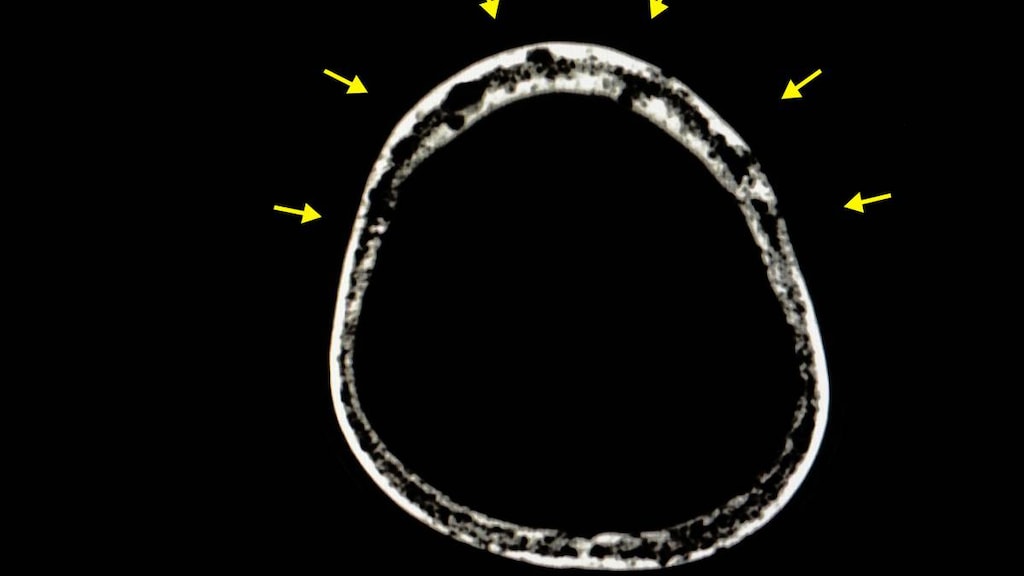Dosage Forms
Excipient information presented when available (limited, particularly for generics); consult specific product labeling.
Solution, Subcutaneous [preservative free]:
Mozobil: 24 mg/1.2 mL (1.2 mL)
Pharmacology
Mechanism of Action
Plerixafor reversibly inhibits binding of stromal cell-derived factor-1-alpha (SDF-1α), expressed on bone marrow stromal cells, to the CXC chemokine receptor 4 (CXCR4), resulting in mobilization of hematopoietic stem and progenitor cells from bone marrow into peripheral blood. Plerixafor used in combination with filgrastim results in synergistic increase in CD34+ cell mobilization. Mobilized CD34+ cells are capable of engrafting with extended repopulating capacity.
Pharmacokinetics/Pharmacodynamics
Absorption
SubQ: Rapid; exposure using the mg/kg dosing increases with increasing body weight; the fixed dosing (20 mg) results in higher exposure than the mg/kg dose, but the median time to reach the target cell count is the same for both dosing regimens
Distribution
0.3 L/kg; primarily to extravascular fluid space
Metabolism
Not metabolized
Excretion
Urine (~70%; as parent drug)
Onset of Action
Peak CD34+ mobilization (healthy volunteers): Plerixafor monotherapy: 6 to 9 hours after administration; Plerixafor + filgrastim: 10 to14 hours
Time to Peak
Plasma: SubQ: 30 to 60 minutes
Duration of Action
Sustained elevation in CD34+ cells (healthy volunteers): 4 to 18 hours after administration
Half-Life Elimination
Terminal: 3 to 5 hours
Protein Binding
≤58%
Use in Specific Populations
Special Populations: Renal Function Impairment
Clearance is reduced in patients with renal impairment. When compared to patients with normal renal function, the mean AUC was increased 7% in patients with mild renal impairment (CrCl 51 to 80 mL/minute), 32% for moderate renal impairment (CrCl 31 to 50 mL/minute), and 39% with severe renal impairment (CrCl <31 mL/minute).
Use: Labeled Indications
Peripheral stem cell mobilization: Mobilization of hematopoietic stem cells (HSCs) for collection and subsequent autologous transplantation (in combination with filgrastim) in patients with non-Hodgkin lymphoma (NHL) and multiple myeloma (MM)
Contraindications
History of hypersensitivity to plerixafor or any component of the formulation (anaphylactic shock has occurred).
Dosage and Administration
Dosing: Adult
Note: Dosing is based on actual body weight. Begin plerixafor after patient has received filgrastim for 4 days (refer to Filgrastim monograph for filgrastim dose); plerixafor, filgrastim, and apheresis should be continued daily until sufficient cell collection up to a maximum of 4 days.
Hematopoietic stem cell mobilization (in non-Hodgkin lymphoma and multiple myeloma): SubQ: Administer ~11 hours prior to apheresis
Patients ≤83 kg: 20 mg fixed dose or 0.24 mg/kg once daily for up to 4 consecutive days
Patients >83 kg: 0.24 mg/kg once daily for up to 4 consecutive days; maximum dose: 40 mg daily
Dosing: Geriatric
Refer to adult dosing.
Dosing: Obesity
The manufacturer recommends calculating the dose based on actual weight for patients weighing up to 175% of ideal body weight (maximum dose: 40 mg daily). Dosing in patients >175% of ideal body weight has not been studied.
Administration
SubQ: Administer subcutaneously, ~11 hours prior to initiation of apheresis. In some clinical trials, plerixafor administration began in the evening prior to apheresis; filgrastim was begun on day 1, plerixafor initiated in the evening on day 4 and apheresis in the morning on day 5; with filgrastim, plerixafor, and apheresis then continued daily until sufficient cell collection for autologous transplant (DiPersio 2009a; DiPersio 2009b).
Storage
Store at 25°C (77°F); excursions permitted to 15°C to 30°C (59°F to 86°F).
Drug Interactions
There are no known significant interactions.
Adverse Reactions
Adverse reactions reported with filgrastim combination therapy.
>10%:
Central nervous system: Fatigue (27%), headache (22%), dizziness (11%)
Gastrointestinal: Diarrhea (37%), nausea (34%)
Local: Injection site reaction (34%, including edema, erythema, hematoma, hemorrhage, induration, inflammation, irritation, pain, paresthesia, pruritus, skin rash, urticaria)
Neuromuscular & skeletal: Arthralgia (13%)
1% to 10%:
Central nervous system: Insomnia (7%), malaise (<5%)
Dermatologic: Erythema (<5%), hyperhidrosis (<5%)
Gastrointestinal: Vomiting (10%), flatulence (7%), abdominal distension (<5%), abdominal distress (<5%), abdominal pain (<5%), constipation (<5%), dyspepsia (<5%), oral hypoesthesia (<5%), xerostomia (<5%)
Hematologic & oncologic: Hyperleukocytosis (7%)
Neuromuscular & skeletal: Musculoskeletal pain (<5%)
<1%, postmarketing, and/or case reports: Abnormal dreams, anaphylaxis, diaphoresis, dyspnea, hypersensitivity reaction, hypoxia, leukocytosis, nightmares, orthostatic hypotension, periorbital swelling, syncope, thrombocytopenia
Warnings/Precautions
Concerns related to adverse effects:
- Anaphylactic shock/hypersensitivity: Serious hypersensitivity reactions, including anaphylactic-type reactions (may be life-threatening with serious hypotension and shock) have been reported. Observe patients for hypersensitivity symptoms during, for 30 minutes after administration, and until clinically stable. Medication, personnel, and equipment for hypersensitivity management should be immediately available. Mild-to-moderate allergic reactions may also occur, usually within 30 minutes of administration.
- Hematologic effects: Increases circulating leukocytes when used in conjunction with filgrastim; monitor WBC counts. Thrombocytopenia has been observed; monitor platelet counts.
- Splenic enlargement/rupture: Cases of splenomegaly and/or splenic rupture have been reported with plerixafor when used in conjunction with filgrastim; instruct patients to report left upper quadrant pain or scapular/shoulder tip pain; promptly evaluate in any patient who report these symptoms.
Disease-related concerns:
- Leukemia: Not intended for mobilization in patients with leukemia; may contaminate apheresis product by mobilizing leukemic cells.
- Renal impairment: Primary route of elimination is renal; dosage reduction is recommended in patients with moderate-to-severe renal impairment (CrCl ≤50 mL/minute).
Concurrent drug therapy issues:
- Nephrotoxic drugs: Medications that may reduce renal function or compete for active tubular secretion may increase serum concentrations of plerixafor.
Special populations:
- Obese patients: Use has not been studied in patients weighing >175% of ideal body weight.
Other warnings/precautions:
- Tumor cell mobilization: When used in combination with filgrastim, tumor cells released from marrow could be collected in leukapheresis product; potential effect of tumor cell reinfusion is unknown.
Monitoring Parameters
CBC with differential and platelets; monitor for signs/symptoms of hypersensitivity (during, for 30 minutes after administration, and until clinically stable) and for signs/symptoms of splenomegaly
Evaluate pregnancy status prior to use in females of reproductive potential.
Pregnancy
Pregnancy Considerations
Based on data from animal reproduction studies, in utero exposure to plerixafor may cause fetal harm. Pregnancy should be avoided during therapy.
Evaluate pregnancy status prior to use in females of reproductive potential. Females of reproductive potential should use adequate contraception during treatment and for 1 week after the final plerixafor dose.
Patient Education
What is this drug used for?
- It is used to raise the number of stem cells.
Frequently reported side effects of this drug
- Loss of strength and energy
- Headache
- Trouble sleeping
- Injection site irritation
- Nausea
- Vomiting
- Abdominal pain
- Diarrhea
- Passing gas
- Joint pain
Other side effects of this drug: Talk with your doctor right away if you have any of these signs of:
- Enlarged or ruptured spleen like left upper abdominal pain or left shoulder pain
- Severe dizziness
- Passing out
- Bruising
- Bleeding
- Signs of a significant reaction like wheezing; chest tightness; fever; itching; bad cough; blue skin color; seizures; or swelling of face, lips, tongue, or throat.
Note: This is not a comprehensive list of all side effects. Talk to your doctor if you have questions.
Consumer Information Use and Disclaimer: This information should not be used to decide whether or not to take this medicine or any other medicine. Only the healthcare provider has the knowledge and training to decide which medicines are right for a specific patient. This information does not endorse any medicine as safe, effective, or approved for treating any patient or health condition. This is only a brief summary of general information about this medicine. It does NOT include all information about the possible uses, directions, warnings, precautions, interactions, adverse effects, or risks that may apply to this medicine. This information is not specific medical advice and does not replace information you receive from the healthcare provider. You must talk with the healthcare provider for complete information about the risks and benefits of using this medicine.



